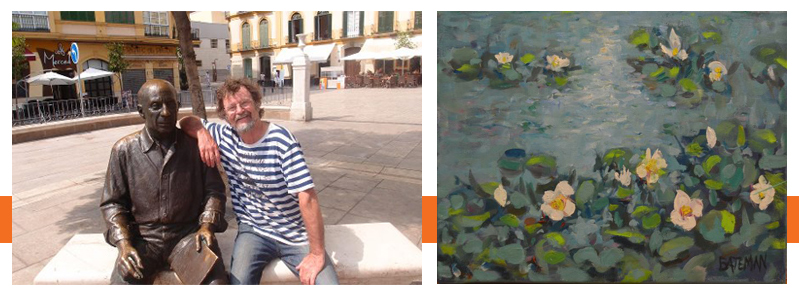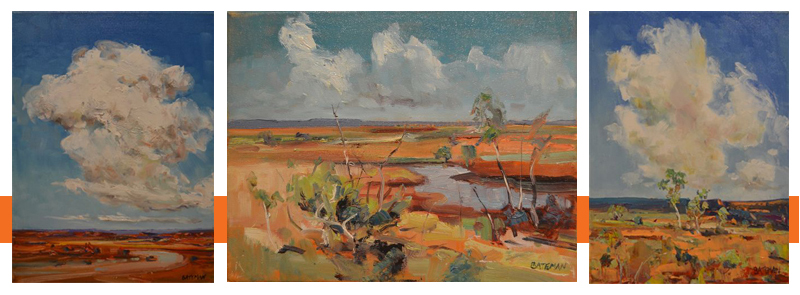The internationally acclaimed leading Australian landscape artist showcases his most recent body of works at Red Hill Gallery. Piers has a keen eye and intuitively captures the spirit of the landscape through his use of bold colour and line, which makes him highly sought after by collectors.

Currently residing in China we have managed to get in touch with Piers for a quick interview and catch up.
AC: Piers, you are currently residing in Shanghai, tell us about your position at the University.
PB: In 2007 I was invited to exhibit at the Shanghai Contemporary Art Fair. My work came to the attention of some prominent people and I was invited to return the following year. In 2009 I was asked if I would accept a position at Shanghai Institute of Visual Art (S.I.V.A.) as an Honorary Professor. I was to be given accommodation, a studio and would be free to paint and lead my own life. Naturally I accepted. (S.I.V.A. is a new arts university and possibly the best equipped of its kind in the world, their policy is to invite leading exponents of the various Art disciplines to accept residencies so the students have a chance to experience influences from the outside world.)
AC: What is it like living in China, do you miss home?
PB: Living in China is very different from my life in Australia in almost every aspect. I live in a small flat, ride an electric scooter, have learnt the Chinese road laws (there aren’t any) and of course eat mainly Chinese cuisine, which by the way is very different from what we think of as “Chinese” in Australia. I have also learnt that there is a very different social culture and mind set in China, and until one adjusts it can be very frustrating to say the least. But when one thinks how quickly China has evolved in the last few decades one has to be very impressed. Unfortunately this development comes at a price to the environment that is very worrying. China is not unaware of the problem but like the rest of the world is having difficulty with the solution. I feel that art will be an important way of addressing this problem. By this I mean that the first impulse of the newly rich is to display their success in material acquisitions such as luxury cars, but later when wealth is accepted people expand their interests into the Arts, Theatre, Music, Art galleries etc. This passive consumption is not only spiritually more satisfying but less damaging to our resources.
AC: You capture the spirit of the Australian landscape so accurately! What draws you to paint a particular scene?
PB: Firstly thank you for the compliment. My paintings are rarely of a particular place. I travel widely and like to interact with my physical location. I like to experience what it is that makes a place unique. This subject could have me going for half an hour! Briefly: as modern artists have realized for over a century, a painting has to succeed as a work of art before any other consideration is given to it. In other words all painting has to be considered in the abstract sense. Composition, and then the other visual elements of line, colour, harmony etc. Subject is of secondary importance, but it is interesting to the viewer and the artist from a personal point of view. We all like to feel that we “know” a place, it brings us memories of places we know or experiences of places we would like to know. An artist realizes that there are two minds involved with a work of art, the artist’s and the viewer’s. The painting if you like is a vehicle to connect one mind with another. I always feel these things are more easily understood when we consider music. Enough! I am writing a booklet on this at the moment.
AC: Your work is in many major corporate collections and the Australian Embassy in Washington, how do you feel about your paintings being so highly sort after and represented?
PB: It is very satisfying to find my work permanently displayed in many different places in Australia and around the world. I remember to this day the letter I got in London in 1967 telling me that I had sold three small paintings in a group exhibition. It gave me so much confidence, to realize that someone (other than my mother!) found some meaning in my work. As a professional artist who has never received Government funding, selling paintings, is absolutely vital to my existence as an artist. The small collectors who buy the occasional painting do more to support artists and art than any Government grants, which tend to favour the few.
AC: So we heard you have an art studio in Spain?! How often do you visit it and Why Spain?
PB: My connection with Spain is many layered, from my Grandfather who was born in Columbia to a Spanish mother, to my sister who married a Spaniard with family in Malaga where I bought a small piece of land in the country (El campo). This land had an old ruin which over the last ten years we transformed into a small traditional house with a separate studio. Spain has many similarities with Australia, the climate, the love of the good life, food and wine and of course sport. I have managed to visit nearly every year, especially when I was building the house and now I would like to conduct workshops there with up to six people to experience the Andalusian life. Fiesta, food, wine, dancing and of course art!! Andalucía Festival.
AC: I recently heard a funny story about you asking Arthur Boyd to teach you how to paint. Can you share with our readers what happened next and give us a little insight into your relationship with this amazing Australian artist.
PB: When I was a callow youth living in London with aspirations to being a painter, I wrote a letter to Arthur Boyd, whom I knew slightly, asking him if it might be possible to become a sort of apprentice as in the renaissance tradition. He didn’t reply but when I saw him again he mentioned the letter and said if I wanted a job I could paint his house. Needless to say I jumped at the chance and after doing a satisfactory job was kept on as a sort of studio assistant. He made his own paint and was extremely fastidious with preparation of his boards, I had to put on seventeen layers of gesso ground, fine sanded every third layer for use as a base for egg tempera (paint medium). I lived in the basement room and had in my room some of the most famous paintings from his “Blackman and his Bride” series as well as many others. I knew at the time what an amazing privilege it was. Boyd taught me the importance of hard work as an artist. During the painting of the house which was incidentally four stories high I had to paint the eves with a large extension ladder at full stretch. It was a little short so I put it on top of a washing machine crate to get the extra height. Well he nearly had a fit and raced up stairs and tied the ladder to the bathroom plumbing and made me come down. I didn’t know what the fuss was about, I was nineteen.
AC: What do you do when you are not working on your art?
PB: At the moment that (art) is taking up most of my time. I have just come back from a month in Spain with my 19 year old son who is studying in Holland. (So he will be qualified for a “proper “Job!) I am very keen on sailing and have lived on a yacht for several years in the Mediterranean. And of course I am an addicted traveller. Travelling makes me think that I am getting somewhere!
AC: Describe your art in one sentence.
PB: My art is about trying to solve the elusive puzzle that has fascinated artists since art was discovered, the mystery of the human mind and the amazing accuracy of the eye.
AC: What is your favourite childhood memory?
PB: Holidays at the beach at San Remo Victoria, swimming, fishing and dreaming of being old enough to drive an MG and have a girl friend with similar carnal desires!!
AC: Finally, what does your art mean to you and what do you hope it means to your collectors?
PB: Art is to me the most important thing after survival needs. By art I include of course all the arts. I like to say as a definition of art. Art is the seduction of the senses. Art is to be explored, enjoyed questioned and collected.
When I was about twenty one I once delivered a painting of mine to a famous Melbourne collector who had so many paintings they were hung from ceiling to floor. Boyds, Streetons, McCubbins, Blackmans, (Charles Blackman at Red Hill Gallery) etc. He offered me a cup of coffee and spoke of his collection. He said his business associates constantly asked him why he didn’t sell the collection now that it had become so valuable. He said “every morning before I go in to the office I sit here for ten minutes with a coffee and feel invigourated for the rest of the day. If I framed my shares and put them on the wall they would give me no pleasure whatsoever.”




